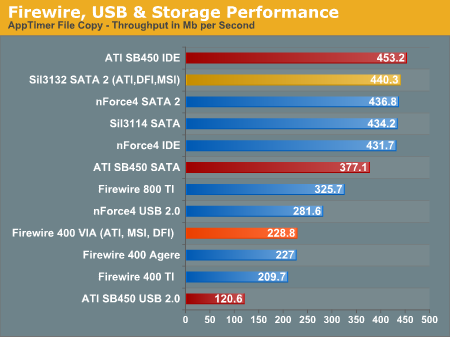Sapphire PURE Innovation - ATI's Chipset for the AMD Enthusiast
by Wesley Fink on July 29, 2005 12:05 AM EST- Posted in
- Motherboards
Firewire and USB Performance
It is really difficult to put together a simple, repeatable, and consistent test to measure USB and Firewire Performance. Since our goal was to make this a standard part of motherboard testing, we needed a benchmark that was reasonably simple to run that would also provide consistent results on the same test bed. We finally determined that an external USB 2.0, Firewire 400, and Firewire 800 hard disk might be a sensible way to look at USB and Firewire throughput.Our first efforts at testing with an IDE or SATA drive as the "server" yielded very inconsistent results, since Windows XP sets up cache schemes to improve performance. Finally, we decided to try a RAM disk as our "server", since memory removed almost all overhead from the serving end. We also managed to turn off disk caching on the USB and Firewire side by setting up the drives for "quick disconnect" and our results were then consistent over many test runs.
We used just 1GB of fast 2-2-2 system memory set up as a 450MB RAM disk and 550MB of system memory. Our stock file was the SPECviewPerf install file, which is 432,533,504 bytes (412.4961MB). After copying this file to our RAM disk, we measured the time for writing from the RAM disk to our external USB 2.0 or Firewire 400 or Firewire 800 drive using a Windows timing program written for AnandTech by our own Jason Clark. The copy times in seconds were then converted into Megabits per second (Mb) to provide a convenient means of comparing throughput. Higher Rates, therefore, mean better performance.

Sapphire PURE Innovation uses the commonly available and good-performing VIA Firewire 400 chip. Firewire 800 is 40 to 55% faster than a drive connected to Firewire 400, but it is still rare to find Firewire 800 integrated into motherboards.
Perhaps the biggest surprise in our testing was the poor performance of USB 2.0 on the Sapphire ATI. ATI had promised improvement in USB performance in the SB450 compared to the earlier SB400, but we could see little improvement in our USB 2.0 tests. ATI has responded that our USB 2.0 tests measure sustained throughput, which is relevant in USB operations only with applications like the USB 2.0 hard drive that we use for this test. ATI states that "burst" USB 2.0 throughput has been improved in the SB450 to near the same levels of competitive USB 2.0 peak performance. Perhaps even more important, ATI say that they are aware of the issues with USB 2.0 performance and these will be fully corrected - sustained and peak performance - in the SB600 south bridge.
Since our ramdisk/apptimer File Copy is measuring sustained throughput, we also compared performance of ATI IDE/SATA/Sil SATA2 using this same test procedure. The performance of ATI IDE remains excellent, but SATA and SATA 2 performance are very competitive, yet not standout as in the iPeak storage benchmarks of the same controllers. This lends some credibility to ATI's comments that their USB 2.0 performance is competitive when burst performance is measured.










52 Comments
View All Comments
IRQ Conflict - Friday, July 29, 2005 - link
I was just at ATI's site and they list this as the http://www.ati.com/buy/promotions/radeonxpressmobo...">PI-A8XRX480. Someone have thier wires crossfired? ;)IRQ Conflict - Friday, July 29, 2005 - link
WOOT! been waiting a long time for this board! dissapoints me that there doesn't appear to be a version with the x300 IGP though.